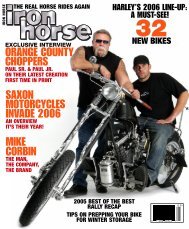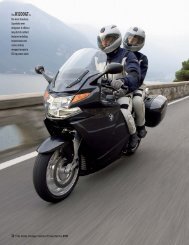EXCWSIVE 200 AMAZING MILES ON HONDA'SV~s + VFR1200F ...
EXCWSIVE 200 AMAZING MILES ON HONDA'SV~s + VFR1200F ...
EXCWSIVE 200 AMAZING MILES ON HONDA'SV~s + VFR1200F ...
Create successful ePaper yourself
Turn your PDF publications into a flip-book with our unique Google optimized e-Paper software.
184BHP<br />
WHY DID BMW DO IT?<br />
In January <strong>200</strong>5, at the launch the R1<strong>200</strong>RT, ex-BMW<br />
Motorrad boss Dr Herbert Diess told a small group of<br />
journalists that BMW were changing. His bosses had<br />
decided they needed to sell more bikes and increase<br />
their market share. Dr Diess told us BMW needed to<br />
bring the brand values of their cars to their bikes: quality,<br />
luxury, technology and - specifically - performance. The<br />
inference was clear and Bike reported it in the R1<strong>200</strong>RT<br />
launch report: 'In short, BMW want to build sportsbikes.'<br />
This may only be five years ago, but how quickly we<br />
forget that BMW in <strong>200</strong>5 were not like BMW in 2010.<br />
While their cars had long been associated with quality,<br />
luxury, technology and performance, their bikes could<br />
only tick one, maybe two, of those boxes.<br />
BMW were at the cutting edge of something but<br />
it wasn't performance and it wasn't technology, the<br />
quality didn't extend to their gearboxes and the luxury<br />
amounted to heated grips, big fairings and decent tank<br />
ranges. While the Japanese built bikes people wanted,<br />
BMW built bikes they thought people should want.<br />
Their particular brand of 'we're right, the rest of the<br />
world is wrong' was exemplified by their use of<br />
unconventional indicator switchgear. It was this kind<br />
of design obstinacy that put people off buying BMWs<br />
when they went for a ten-minute test ride.<br />
Five years later, BMW are a very different company,<br />
with the S1000RR reflecting the strengths of BMW cars.<br />
And it even has push-to-cancel indicators on the left bar.<br />
Not reinventing the<br />
wheel has allowed<br />
BMW to leapfrog rivals<br />
184BHP<br />
HOW DID BMW DO IT?<br />
By choosing to build a Japanese-style 16 valve, watercooled<br />
in line four housed in a conventional twin spar<br />
aluminium frame, BMW selected a design with a clear,<br />
linear development history. Thus it was easier to play<br />
catch up - or leapfrog - when designing their own<br />
engine, rather than expend a lot of development time<br />
and cost pursuing a new direction (as, perhaps, Aprilia<br />
have with their V4-powered RSV4). BMW could study a<br />
very obvious Japanese development cycle - anyone<br />
familiar with the recent history ofGSX-Rs, ZX-10Rs, R1s<br />
D 'The Suzuki GSX-Rl000KS was the<br />
best litre sportsbike - and it still is. It<br />
is the bike we used as a benchmark'<br />
and Blades would have no trouble predicting future<br />
power increases with a fair degree ofaccuracy - and<br />
pitch their engine's spec a few years ahead of its rivals.<br />
BMW acknowledge as much: 'The principle of<br />
combining a straight-four power unit with an aluminium<br />
bridge frame has been consistently developed and has<br />
become the dominating technical concept, particularly<br />
in the supers ports segment. The reason, quite simply, is<br />
that a motorcycle of this kind offers significant benefits<br />
in terms of riding dynamics, long-distance endurance<br />
and straightforward production.'<br />
This is backed up by BMW's Stefan Zeit, project<br />
leader for the S1000RR, who recently spoke to Bike<br />
about the role the opposition litre sportsbikes played<br />
in the development of the S1000RR.<br />
'We tested the competition: he said. 'I was<br />
particularly impressed by the Fireblade. But I don't<br />
understand why Yamaha have used the crossplane<br />
crank in a road bike. I feel it is not a nice engine to use.'<br />
But Zeit reserved his greatest praise not for a current<br />
sportsbike, but a five-year-old model: 'Early, while we<br />
were developing the S1000RR,at the time the Suzuki<br />
GSX-R1000K5 (see p 116) was the best litre sportsbikeand<br />
I think it still is. It is the bike we used as a benchmark<br />
for the S1000RR; we bought ten of them and pulled<br />
them apart. In engineering terms it is so light. and so<br />
simple. I cannot understand why Suzuki went away<br />
from this design and made the K7 and the K9.'<br />
At the recent Milan show, when the S1000RR was<br />
debuted to the public for the first time, BMW staff were<br />
amused by the sight of Japanese gentlemen with tape<br />
measures noting down various dimensions of the bike.<br />
'We also had a lot of questions from Aprilia too, about<br />
our traction control system!' noted Zeit with a smile.<br />
Zeit added. 'We know, for certain, that all the<br />
Japanese manufacturers have advanced traction<br />
control systems on a shelf, ready to be used. But they<br />
have not used them. It seems very strange.'<br />
One thing's for sure: expect a Japanese response in<br />
2011. Traction-controlled, <strong>200</strong>bhp Blade, anyone?<br />
9





